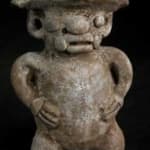Shaman Effigy Whistle, 300 BCE - 300 CE
Terracotta
3.125 x 5.375
PF.4315
Further images
Whistles were a form of musical instruments from the New World. They were found in high-status tombs. This intriguing whistle suggests its use in rituals and ceremonies. This whistle is...
Whistles were a form of musical instruments from the New World. They were found in high-status tombs. This intriguing whistle suggests its use in rituals and ceremonies. This whistle is in the shape of a shaman that symbolizes the spiritual and mythological beliefs of the Costa Ricans. Perhaps they used this whistle during hallucinogenic trances to heighten the shaman’s enlightenment and overall experience. Therefore, the ceremonies and rituals they used this instrument in were important to the health security of the tribe. The artistic depiction of this shaman is burnished in a grayish-brown color. There are no images of tribal tattooing. A very unique feature is the realistically depicted headdress. This shaman is wearing a broad headdress, with a streamline-raised center representing a type of armor. The original headdress most probably was made out of hide and feathers. This figure is highly stylized. The facial features of the shaman depict him as if he is in a trance. The eyes are not clearly defined, but the mouth is opened and flanked by two circular designs. The arms loop out and around and the hands are placed on his hips. The earlobes are pierced with holes. The two legs make the front support of the tripod while an amphibious tail serves as the third leg of the tripod and as the air hole. There is another large hole in the center of the back that is the blowhole to this whistle. Musical instruments with symbolic importance such as this one are a rarity. This unique piece gives us a glimpse into the culture of ritualistic, spiritual and domestic activities of the Costa Ricans.







